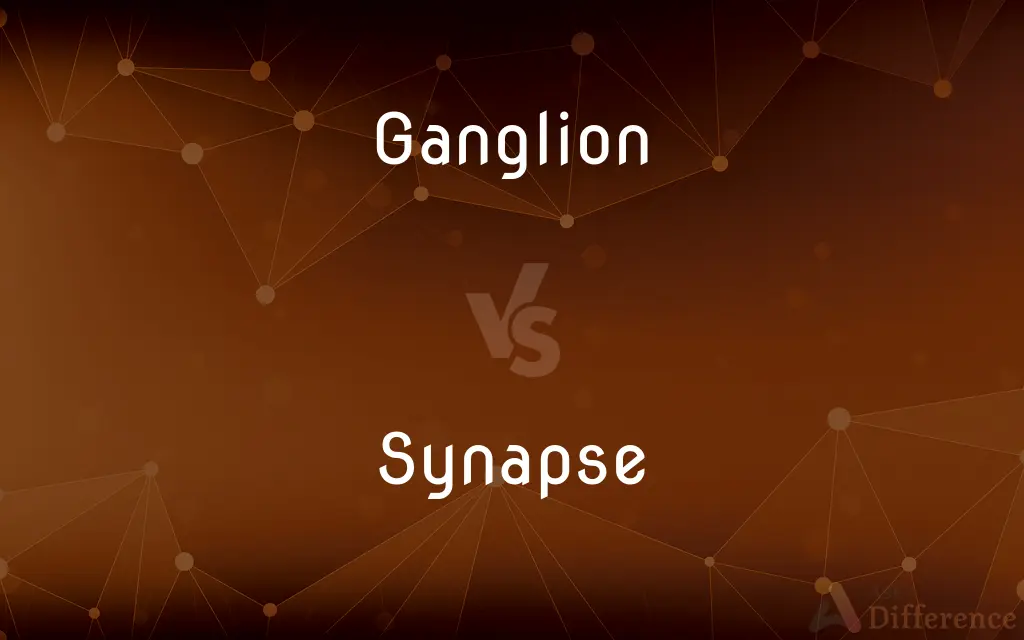Ganglion vs. Synapse — What's the Difference?
A ganglion is a cluster of nerve cell bodies outside the CNS, while a synapse is the junction between two nerve cells where signals are transmitted. They differ in structure and function in the nervous system.

Difference Between Ganglion and Synapse
Table of Contents
ADVERTISEMENT
Key Differences
Ganglion: A ganglion refers to a collection of nerve cell bodies located outside the central nervous system, primarily in the peripheral nervous system. Ganglia provide relay points and intersections for transmitting neurological signals. Synapses, on the other hand, are the actual points of signal transmission.
Synapse: The term synapse designates the specialized junctions through which neurons signal to each other and to non-neuronal cells like muscles or glands. They are integral to the propagation of nerve impulses. Ganglion, in contrast, represents groupings of nerve cell bodies.
Structural Differences: A ganglion generally presents as a visible bump or node containing numerous nerve cell bodies. In contrast, a synapse is microscopic and involves the end of one neuron, the synaptic cleft, and the beginning of another neuron. The distinction between ganglion and synapse lies in their composition and visibility.
Functional Differences: Ganglia serve as hubs in the peripheral nervous system, housing cell bodies of neurons. They often relay and process signals. Synapses are the points where the actual transmission of the signal occurs between neurons, ensuring communication within the nervous system.
Location and Presence: Ganglia are mainly seen in the peripheral nervous system, although some exist in certain brain structures. Synapses are ubiquitous throughout both the central and peripheral nervous systems, facilitating neural communication.
ADVERTISEMENT
Comparison Chart
Definition
Cluster of nerve cell bodies
Junction between two nerve cells
Location
Mainly in the peripheral nervous system
Throughout central and peripheral nervous systems
Function
Relay and process signals
Transmit signals between neurons
Structure
Visible node containing nerve cell bodies
Microscopic involving neuron ends and synaptic cleft
Presence
More specific locations
Ubiquitous in the nervous system
Compare with Definitions
Ganglion
A collection of nerve cell bodies.
The dorsal root ganglion contains sensory neuron cell bodies.
Synapse
A junction between two nerve cells.
The neurotransmitters cross the synapse to propagate the signal.
Ganglion
A nerve tissue cluster outside the CNS.
The surgeon removed a cyst near the wrist ganglion.
Synapse
A point ensuring neural communication.
A malfunctioning synapse can lead to neurological issues.
Ganglion
A relay point in the peripheral nervous system.
The ganglion played a role in transmitting the sensory information.
Synapse
A specialized structure for neural signals.
The brain has trillions of synapses ensuring its complex operations.
Ganglion
A visible node in the nervous system.
The ganglion could be felt as a bump near the surface.
Synapse
A connection involving a synaptic cleft and neuron ends.
The synapse ensures the one-way transmission of nerve impulses.
Ganglion
A group of nerve cells forming a nerve center, especially one located outside the brain or spinal cord.
Synapse
The site of signal transmission in the nervous system.
The efficiency of the synapse determines the speed of neural communication.
Ganglion
(Medicine) A benign cystic lesion resembling a tumor, occurring in a tendon sheath or joint capsule.
Synapse
The junction across which a nerve impulse passes from an axon terminal to a neuron, muscle cell, or gland cell.
Ganglion
A center of power, activity, or energy.
Synapse
To form a synapse.
Ganglion
(neuroanatomy)
Synapse
To undergo synapsis.
Ganglion
An encapsulated collection of nerve cell bodies, typically linked by synapses, and often forming a swelling on a nerve fiber.
Synapse
The junction between the terminal of a neuron and either another neuron or a muscle or gland cell, over which nerve impulses pass.
Ganglion
Any of certain masses of gray matter in the central nervous system, as the basal ganglia.
Synapse
(intransitive) To form a synapse.
Ganglion
(transferred sense) A centre of intellectual or industrial force, activity, etc.
Synapse
(intransitive) To undergo synapsis.
Ganglion
(pathology) A benign cystic tumour on a tendon sheath or joint capsule.
Synapse
The junction between two neurons (axon-to-dendrite) or between a neuron and a muscle;
Nerve impulses cross a synapse through the action of neurotransmitters
Ganglion
A mass or knot of nervous matter, including nerve cells, usually forming an enlargement in the course of a nerve.
Ganglion
A globular, hard, indolent tumor, situated somewhere on a tendon, and commonly formed by the effusion of a viscid fluid into it; - called also weeping sinew.
Ganglion
An encapsulated neural structure consisting of a collection of cell bodies or neurons
Ganglion
A central hub for certain nerve pathways.
The ciliary ganglion is involved in certain eye functions.
Common Curiosities
Are synapses only present in the brain?
No, synapses are found throughout the central and peripheral nervous systems.
Can you see a ganglion?
Yes, some ganglia can be seen and felt as bumps, especially those near the skin.
How do drugs affect synapses?
Many drugs can enhance or inhibit neurotransmitter activity at synapses, affecting signal transmission.
What is a ganglion in simple terms?
A ganglion is a cluster of nerve cell bodies located outside the central nervous system.
How do ganglia and synapses relate to each other?
Ganglia house neuron cell bodies, while synapses are where these neurons communicate.
Why are synapses important?
Synapses are essential for all neural functions, from reflexes to complex thought processes.
How do synapses ensure one-way communication?
Synapses are designed so that neurotransmitters only flow from the presynaptic to the postsynaptic neuron.
How many synapses does a neuron have?
A neuron can form thousands of synapses with other cells.
What's the primary role of a synapse?
A synapse is where two neurons meet and transmit signals to each other.
Do all neurons in a ganglion have the same function?
No, a ganglion can contain various neurons with different functions.
Is the synapse only about electrical transmission?
No, synapses can be electrical or chemical, with the latter involving neurotransmitters.
Can a ganglion be harmful?
While many are harmless, some ganglion cysts or tumors may require medical attention.
What causes a ganglion cyst?
The exact cause is unclear, but joint or tendon irritation is often associated.
Can ganglia be found in the brain?
While most are in the peripheral nervous system, certain brain structures like the basal ganglia exist.
Are ganglia unique to humans?
No, many vertebrates have ganglia in their nervous systems.
Share Your Discovery

Previous Comparison
Ordinary Annuity vs. Annuity Due
Next Comparison
Internal Recruitment vs. External Recruitment













































